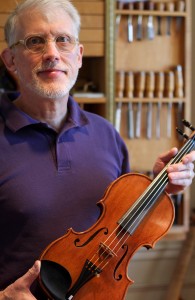Throughout the last century, emails have replaced handwritten notes and washing machines have replaced hand-washing clothes. No one uses encyclopedias anymore, because looking up something in a book is so 20th century. Changing camera film? Nope, we’ve gone digital.
These technological advances have spawned a society in which very few people have the patience to accomplish a task in an “old-school” way — we are a busy and efficient people.
Except Tim Johnson.
Johnson is a luthier, or maker of stringed instruments. A Hewitt resident with more than 30 years of experience, he has become an expert at using hand tools to turn wooden logs into beautiful and professional lutes, violins, violas and cellos.
Answering why he chooses to make instruments when machines can do the same thing, he reflects on conversations with musicians and acknowledges what keeps him grounded in the hand-making tradition.
“A lot of people who have shop-made instruments have told me that the instrument is soulless,” he said. “They can tell that somebody hasn’t put their labor and love into it, and I have to believe there is something about making the instrument by hand that gives it life.”
The son of a Connecticut minister and a stay-at-home mother, Johnson grew up knowing that if he wanted something, he had to make it. So when he saw a photo of a Renaissance lute in eighth grade, that’s exactly what he did.

“Making stuff is what my family did,” he said, adding that the family’s lack of money was almost a blessing because being handy led to his eventual career.
Though Johnson played the oboe growing up, he gravitated toward building instruments, and he attempted making another lute during his senior year of high school. The finished product accompanied him throughout his studies at Harvard University, where he began as an oboe performance major, changed to history, and ultimately received a degree in general studies.
His education continued at Longy School of Music in Cambridge, Mass., where he received a music performance degree in baroque oboe and renaissance winds, and culminated at Indiana University’s Jacobs School of Music, where he studied violin making and restoration.
“I really didn’t think about making instruments for a living until I got to Indiana,” Johnson said. “I thought it was too much fun and I wasn’t taking it seriously, but my destiny really caught up with me.”
He has since built a network of clients in cities including New York, Boston, San Francisco and The Hauge, located in the Netherlands.
Because of the physical distance between himself and a client, it is necessary to speak via telephone about what kind of music will be performed on the instrument and what kind of sound the musician is looking for.
“Players come up with wonderful ways of describing sound, and many talk about it as they would coffee or dessert, like dark or chocolaty,” he said.
Dr. Kathryn Steely, professor of viola in the Baylor University School of Music, has worked extensively with Johnson and his instruments, and said he is one-of-a- kind in the business. She cited his deep historical knowledge, interest in his craft, research participation and attention to detail as being a perfect combination for making “works of functional art.”
“Many choices are made in the process of instrument construction, and those choices result in a particular sound in the end,” she said. “The luthier must have a keen understanding of how even the most minor adjustments can have a major impact on the player’s ability to perform well.”
Johnson compared his profession to those of NASCAR mechanics, explaining how one tweak to a car part and one small change to an instrument both have the potential to drastically improve the outcome of the performance.
“As a maker, I have to try from the very start to get as many little things right as possible,” Johnson said, “It basically starts from the log, when I select the proper stiffness, density and quality of wood before I can begin to shape it.”
One quality he has developed from his intensive work is synaesthesia, or the concept of hearing with the eyes and seeing with the ears. Simply hearing an instrument allows Johnson to visualize the shape of it, and simply seeing it allows him to imagine the sound it will likely produce.
The instrument doesn’t have to be beautiful to sound beautiful, he said. But it certainly helps.
Steely said the instruments that emerge from Johnson’s workshop are always “shaped to perfection,” a result of the many minutes, hours and months he spends laboring over the details of the wood.
“I spend a lot of time looking at the wood as I shape it and it becomes a beautiful thing,” he said.
With the huge quantity of well-trained classical musicians today comes incredible pressure for players to perform at their peak at all times, which results in musicians setting high standards for the luthier. Johnson credits critical feedback from his clients as the best teacher he’s ever had.
“I have to put my ego aside and just listen when people are giving me feedback so I can constantly perfect the craft,” he said.
His ability to interpret specific requests has spilled over into his personal life as well.
“Words are an imperfect medium sometimes, and I find my craft has helped me to really listen and be more empathic when others are speaking to me,” he said.
“The world would be a much better place if people tried to feel the meaning behind the words of others.”
Whether building stringed instruments or learning how to listen intently, Johnson believes the energy, labor and love he invests in his work forge instruments with souls.

